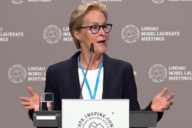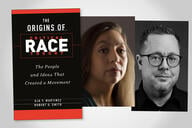You have /5 articles left.
Sign up for a free account or log in.
Visual arts professionals, including art historians, let real and perceived fears about copyright law get in the way of their work, finds a new report from the College Art Association. And while the fundamentally visual nature of their discipline raises particular concerns among scholars of art, artists, editors and museum curators, experts say their fears are shared across academe -- although some disciplines have worked to develop codes to help scholars navigate the murky waters of fair use.
"The visual arts communities of practice share a common problem in their confusion about and misunderstanding of the nature of copyright law and the availability of fair use," reads the report, called "Copyright, Permissions, and Fair Use Among Visual Artists and the Academic and Museum Visual Arts Communities." "Their work is constrained and censored, most powerfully by themselves, because of the confusion and the resulting fear and anxiety."
In addition to a lack of clarity of about what is fair use -- the section of copyright law allowing for non-licensed use of copyrighted material for commentary and other "transformative" purposes -- arts professionals fear the costs, in time and dollars, of seeking out permission for licensed use, the report says. (Note: This sentence has been updated from an earlier version.) It calls these anxieties part of a larger "permissions culture," in which there is a presumption that licensed use is necessary -- even when, in reality, there are many uses for which it is not.
According to a survey of CAA members that makes up part of the report, one-third had avoided or abandoned a project due to an "actual or perceived inability to obtain permission to use third-party works." Within that group, 39 percent of academics said they had done so. (Editors and publishers were the most affected group, with 57 percent reporting dropping a project; visual artists were least likely to report doing so.)
CAA commissioned well-known intellectual property scholars Patricia Aufderheide, a professor at American University’s School of Communication and director of its Center for Media and Social Impact, and Peter Jaszi, professor of law at the American University Washington College of Law, to lead the report. In addition to the survey, their team conducted 100 interviews with arts professionals and additional interviews with copyright holders, plus a literature review of scholarly writing on art and copyright.
Researchers found that arts professionals' timidity stemmed from "exaggerated risk assessment," which they found to be more pronounced among non-artists, such as scholars of art. Interviewees often equated "conservative, even self-censoring choices with acceptable security," taking on a "better safe than sorry" attitude, the study says. Art historians in particular considered not only their own risk using non-licensed material, but also reported fearing that future academics would be made vulnerable by referencing their (unlicensed) application of copyrighted material. In reality, says the report, such "downstream" risk is low.
Part of the problem stems from a lack of formal education about fair use laws. Most interviewees had only informal education on fair use, including 77 percent of academics in the arts. They reported learning about fair use from their institutions' lawyers, the Internet, colleagues, listservs and, in one case, "rumor."
In addition to dropped projects, the report says copyright confusion and failure to employ fair use laws in the visual arts result in: unnecessary delay and expense; subordination of creative decision-making to the availability of creative materials and cooperativeness of providers; and failure to innovate in the digital environment. (The report finds that copyright concerns are heightened in the digital environment. Think Aaron Swartz, who found himself the subject of a federal investigation after downloading JSTOR documents using computers at Massachusetts Institute of Technology. Although accused of more than copyright violations, his case heightened awareness among academics of the gray and -- for some -- outdated nature of Internet law.) (Note: This paragraph has been updated from an earlier version to reflect that Swartz did not release the documents.)
But, it says, "More and better work can be done through a fuller understanding of copyright, without impairing the ability of artists and art historians to receive credit for, maintain appropriate control over, and monetize their work."
Arts professionals can best help each other to understand copyright and fair use, the report says, by establishing best practices for the discipline. The CAA is in the process of creating a copyright and fair use code for its members.
In an interview, Aufderheide said a code won't fully solve creative professionals' fair use problem, and that, ultimately, each question about fair use will have to be answered on a case-by-case basis. But a strong code of best practices will help reduce anxiety among professionals wanting to incorporate copyrighted material into their work by giving them a starting point, she said. Documentary filmmakers, for example, were able to find insurance for copyright infringement once a best practices code was established for them, she said. Other professional associations with codes include the Association for Research Libraries and the International Communications Association.
Aufderheide said other academic disciplines -- even those that aren't as explicitly visual -- are lacking a code of best practices for fair use. (Historians, she said, don't have a code but are particularly good "fair users," likely due to their constant reliance on third-party material.)
In short, she said, the findings and recommendations of the CAA study are applicable to academe overall.
"Many, many academic authors have had the experience of being told by their publisher, 'You can't use that illustration because you didn't get clearance,' " Aufderheide said, or wonder how much of another scholar's words they can quote in their own work without needing to obtain permission.
Jessica Litman, a professor of law and information at the University of Michigan who specializes in intellectual property, agreed, saying "many academics are reluctant to use texts and images for which they may need to ask permission."
And publication presents another hurdle, Litman said. "Many scholarly, academic, and commercial publishers of scholarship insist that authors supply signed permission documents even for uses that are almost certainly fair and even for the use of texts or images that are in the public domain."
Corynne McSherry, director of intellectual property at the Electronic Freedom Foundation, said she wasn't surprised by the report, given the amount of "misinformation out there." Like Aufderheide, she said she didn't think it was confined to the visual arts, but said that was "ironic," as educational uses of copyrighted material often qualify as fair.
Other experts agreed that best practices were important, but emphasized that fair use -- even with the best code -- is never black and white. Steven J. McDonald, general counsel for the Rhode Island School of Design, said via email that "that fair use is always, inherently a 'gray' area, with each situation depending entirely, and heavily, on the specific facts."
But, he added: "From my perspective, that's not actually a bad thing, because it allows the courts to 'do the right thing' in the face of new situations and new contexts, and it encourages people (at least those who think about it) to stake out a reasonable middle position. But it certainly also can drive people crazy. What I like about the 'best practices' approach is that it helps people figure out where that reasonable middle position is, without being doctrinaire or inflexible."
Joseph Reagle, an assistant professor of communications studies at Northeastern University and faculty associate at the Berkman Center for Internet and Society at Harvard University, described the complexity of fair use in everyday life via email: "I believe the understanding of scholars, instructors, and students about the use of copyrighted works is complex and this complexity is mediated by a ease-of-use and sense of risk, rather than careful thought about legality or even morality. For instance, behind a course firewall, I might make a PDF of a chapter available to students for free."
But, he said, "If I use more than two chapters, I have the students buy the book. I believe this is ethical and probably legal though that might be contested. However, if I don't make the students read all the chapters in a book they've purchased, some will complain and said I should've just provided the scans."
For that reason, he says, he prefers whenever possible to use creative commons-licensed materials. As the interest in "free culture" has grown, he added, it's been easier to find that content.





